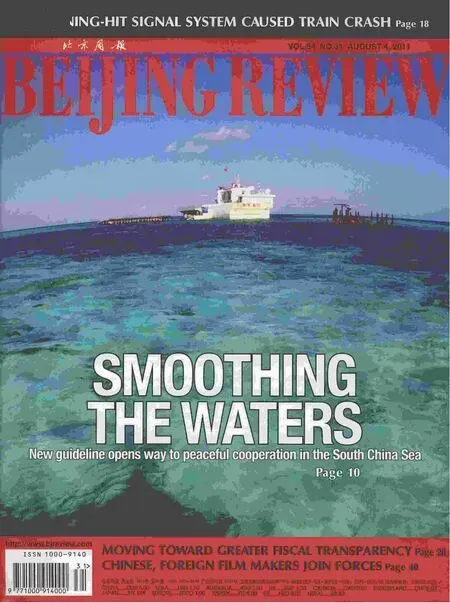Reining in Coercive Power
2011-12-24ByWANGHAIRONG
By WANG HAIRONG
Reining in Coercive Power
By WANG HAIRONG
Law furthers administration system
On June 30, the Standing Committee of the 11th National People’s Congress (NPC), China’s top legislature, adopted the Law on Administrative Coercion at its 21st meeting.
“The law stipulates specific procedures and limits for implementing administrative coercive measures, which is of significant importance to regulate the work of administrative agencies and ensure the legal rights of citizens, corporations and other organizations,” said Wu Bangguo, Chairman of the NPC Standing Committee.
To further its objective of establishing an administrative system based frmly on the rule of law, China has enacted a series of administrative laws over the past three decades, such as the Administrative Review Law and the Administrative Procedure Law.
With the passing of this latest law, China’s legal framework regarding the administrative power of government agencies is now complete, said the Xinhua News Agency.
The law will come into force on January 1, 2012.
China’s administrative coercive system, which, in special circumstances, gives administrative agencies the power to coerce citizens and organizations into complying with state directives, was plagued by two problems, said Xin Chunying, Deputy Director of the Legislative Affairs Commission of the NPC Standing Committee.
Xin said on one hand, administrative coercive measures were often abused, leading to infringement upon the legal rights of citizens, legal persons or other organizations; whereas on the other hand, administrative agencies were often weak in terms of enforcement, so violations of the law could not be effectively addressed.
The new law addresses these two problems, said Yuan Shuhong, Deputy Director of the Legislative Affairs Offce of the State Council, at a press conference held shortly after the law was adopted.
The new law outlaws some of the most complained-about coercive measures, such as forced demolitions that have driven some victims to extreme acts of resistance such as self-immolation.
It also prohibits violent law enforcement or actions taking place on holidays or at night, unless there is an emergency.
Administrative coercive measures were like a double-edged sword, said Ying Songnian, President of the Administrative Law Studies Institute of the China Law Society.
“Used wisely, it can improve administrative efficiency, but otherwise, it may harm citizens,” he said.
Prolonged lawmaking
It took 12 years for legislators to draft and adopt the Law on Administrative Coercion. The drafting process began in 1999 and the NPC Standing Committee reviewed the draft law respectively in December 2005, October 2007 and August 2009. The draft was then published in August 2009 for public feedback, and reviewed by the NPC Standing Committee again this April.
This law governs the coercive power of administrative agencies, which is a more complicated issue than those governed by other administrative laws, Xin said.
There had been four major controversies surrounding the law, said Jiang Ming’an, a Peking University professor specializing in administrative law.
“First, whether such a law is necessary; second, who has the right to institute administrative coercive measures—the NPC, the State Council or local legislatures; third, whether administrative coercive enforcement should be carried out by administrative agencies, the courts, or both, and fourth, how to balance administrative power and citizens’rights. These disputes have slowed down the lawmaking process,” Jiang said.
Moreover, as the law is mainly designed to curb administrative powers, administrative agencies had no incentive to push for the enactment of this law, he said.
At this year’s NPC session, Chairman Wu said the NPC Standing Committee this year would enact in a timely manner laws that are vital for pushing forward scientific development and promoting social harmony in accordance with the overall requirements for improving the socialist system of laws with Chinese characteristics, including the Law on Administrative Coercion.
The lawmaking process had therefore accelerated.
Tougher restrictions
The final version of the Law on Administrative Coercion stipulates government regulations and local regulations cannot set administrative coercive measures if relevant laws do not include such measures.
Previously, administrative coercive measures were stipulated in many administrative regulations and other government documents, so it’s quite difficult to regulate them, Yuan said.
According to Beijing-basedLegal Daily, as of the frst half of 2010, 96 administrative regulations had stipulated administrative coercive measures, though only 17 of these regulations included such provisions because relevant laws authorized the State Council to specify detailed management measures.
The new law says all administrative coercive measures must be instituted by laws, with a small proportion of exceptions for special circumstances, such as state secrets.
Further, the law strives to keep the use of coercive measures to a minimum. “If other non-coercive measures can serve the same end of administrative management, no mandatory measures are allowed,” it says.
Citizens, legal persons or other organizations may raise suggestions to the government departments that set or implement administrative coercive measures. The departments should seriously consider and research the suggestions and offer feedback, the law says.
